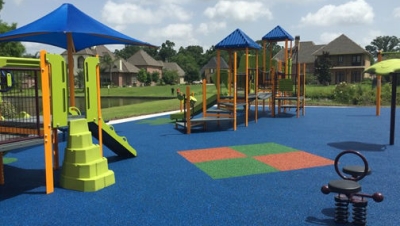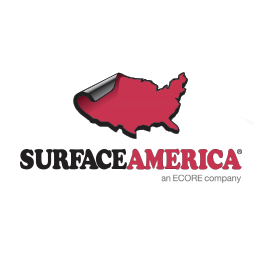POUR IT ON! The who, what, where, and why of poured-in-place playground surfacing
Poured-in-Place is quickly becoming the standard in today’s playgrounds. Due to laws, regulations, and concerned parents, playground builders are installing more and more surfaces that are accessible to all children, prevent serious injury, and are easier and less expensive to maintain. Architects and designers also enjoy Poured-in-Place because of its aesthetics and flexibility. Instead of the traditional playground with sand and equipment, it is now possible to have a jungle with animal-shaped equipment sitting on top of a surface of palm trees and wild grasses. The Girard Street Park in Washington D.C. used Poured-in-Place surfacing to highlight the heritage of their community with a map design.
To better understand Poured-in-Place playground surfacing, we will look at it in terms of who, what, where, and why.
What
Poured-in-place surfacing consists of two layers: a bottom layer of buffings and a top layer of EPDM (ethylene propylene diene methylene terpolymer). The buffings are generally made from recycled rubber (tires) in shredded, flaked, or mulch form. This layer is not compacted into a solid layer but is loosely bonded to make it resilient. The EPDM layer is made of rubber granules that are mixed with a bonding agent and then tightly compacted to make the smooth, seamless surface that is seen. This layer can be colorful, made into patterns, or plain black. Both of these layers are mixed with the bonding agent on site and hand-poured onto the existing surface. The rubber is then hand-trowelled to make one solid surface.
When the Poured-in-Place system connects with a loose fill surface, a turndown method can be used to avoid any seams that might lift, be picked at, or cause trips and falls.
Where
Playgrounds either cover the entire area or use Poured-in-Place in specific areas that need extra padding. Bases of slides, areas underneath elevated equipment, bases of transfer stations, stair entrances, and access paths all have special requirements that are not always met by loose-fill surfacing. Areas under and around elevated equipment are called fall zones. These areas must meet the criteria to prevent injury. There are also regulations that require paths to equipment to be accessible to all participants, regardless of ability level or handicap.
Why
There are many requirements and standards to meet in the playground surfacing industry. ASTM, ADA, and IPEMA are the most widely known certifications and compliance standards. ASTM 1292 is a testing standard for the impact attenuation of protective surfacing. The head injury criteria and velocity at the point of impact are the criteria used to assess the safety of the surface being tested. The ADA Accessibility Guidelines have a specific section, 15.6, for play areas. In it, there are guidelines as to how many paths, equipment pieces, etc. must be accessible in a given playground. Depending on the size of the playground, somewhere between one-half and one-third of the paths and equipment must be accessible to participants of all ability levels. The International Playground Equipment Manufacturer Association, IPEMA, is the association that sets the standard for safety in the industry. When playgrounds are being designed, most planners require that the equipment be IPEMA certified. This certification is also available for playground surfacing. IPEMA certification combines impact attenuation standards (ASTM or equivalent), ADA compliance as well and corporate and raw materials standards for the equipment or surfacing company.
Loose fill surfacing can meet ASTM standards, but because of the constant debris, compacting and removal of the surface, it is timely and expensive to maintain the proper levels and purity. For accessibility paths, most loose fill materials are not sufficient to provide easy travel for all people. For example, it would be quite difficult for a child to roll a wheelchair through 25 feet of sand. Poured-in-Place surfaces require almost no maintenance and do not lose their shape, form, or depth.
Who
The Poured-in-Place industry is still in the shakeout phase of the business cycle. There are three predominant segments: 1) small, mom and pop companies, 2) large companies that specialize in Poured-in-Place, and 3) even larger companies that have a Poured-in-Place division in addition to their other services. The industry consists of mostly regional and a few national companies. The quality, price and methodology vary greatly within each of these segments. Poured-in-Place surfacing is historically higher in price than other types of surfaces out there. One way of lowering prices is to outsource the installation. Another common method is to buy raw materials based on price as opposed to quality.
There are good companies in each of these segments as well as companies to avoid. One way to determine quality is by certifications. If a company is IPEMA certified, it is safe to assume that the quality will be high. It is also good to find out about the installation methods. Some companies will hire laborers to install their surfaces while others actually have fully trained installers on staff that are experts in installing Poured-in-Place.
Loose Fill Vs. Poured-In-Place
There are many benefits to both Poured-in-Place and Loose Fill surfaces. The choice between the two comes down to the playground provider’s preferences and priorities. Three main considerations when comparing Loose Fill surfaces to Poured-in-Place are price, maintenance and safety standards. When it comes to installation price, Loose- Fill has Poured-in-Place beat hands down. However, when considering the cost over the life of the product, the maintenance cost of loose fill is significantly higher.
Maintaining loose fill surfaces involves constant monitoring and weekly to monthly top-offs. Each week, it is required to inspect the loose fill, remove any foreign objects, and ensure that the level meets fall height requirements. If the levels are not deep enough, the area must be topped off. This process ends up being time-consuming and costly. Maintenance for Poured-in-Place involves weekly inspection to remove any debris that may have fallen onto the surface as well as inspection for any cracks, lifting or stains. If there is any damage to the surface, a repair needs to be done. If there is no damage, then a top coat once every three years is all that needs to be done. As discussed earlier, it is possible for both loose fill and Poured-in-Place to meet all fall height requirements. loose fill, however, will not meet all accessibility standards.
There are a few characteristics of Poured-in-Place that cannot be duplicated by loose fill. Poured-in-place surfacing is available in any color imaginable. It can also be manipulated into any shape, pattern, or design because of the hand-pouring installation method. For example, let’s say that an architect wants to have a playground with stars and planets on the surface to make it look like a solar system. The Poured-in-Place installers would use stencils to make the star and planet shapes then use turndown and layering methods to create a seamless surface. A stencil in the shape of a star would be placed on top of the buffing layer and then filled in with yellow, white, purple, orange, gold, silver, or any other color of EPDM that has been mixed with a bonding agent. After the shapes have been established, the main color will be poured in to connect with all of the shapes. Even though different colors and different pours occur throughout the surface as soon as the EPDM layer dries and the top coat is in place, there is one solid, smooth play surface.
When considering what type of surfacing to use on a playground, the decision must be made as to what is the most important qualification. If there is sufficient funding, an entire system of Poured-in-Place may make sense. When there are budget restraints, many planners have opted for a majority loose-fill playground with Poured-in-Place just in the areas that need to meet fall height and accessibility requirements.
Conclusion
The main reason for installing Poured-in-Place rubber surfacing is for safety. Roughly 70 percent of all playground injuries are a result of falls from equipment to the ground. If installed correctly, and to the proper fall-height depth specifications, Poured-in-Place can significantly decrease the risk of serious injuries.














